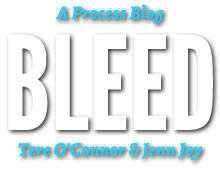There are other worlds…worlds in which recognition is not the only barometer of brilliance or human worth… there are other worlds… dreams in which failure is feasible even worth striving for… there are other worlds…
— Lovett/Codagone WEIGHTED (2010, words taken from Arundhati Roy))
The studio is crowded, even more so now. Leaving rehearsal, Tere, I sense BLEED as a requiem for the three previous dances or perhaps for a limited idea of dance beholden to representation that you have no interest in delivering on. Instead, you conjure other worlds baroquely melancholic, dark, vertiginous and electric. I wonder watching BLEED if I am not too haunted by memories of gesture, of phrase, of image traced in Secret Mary, poem and my imagined sense of Sister. What to do with these many ghosts unleashed through physicality and voice? How do these recollections sit against the gorgeous vivisection happening in front of me now?
BLEED is deeply tied to disappearance and memory as the individual dancers almost disappear into the crowd coming into view only in flashes as devynn and Mary roll into the waiting laps of other dancers becoming airborne swimmers or later in their oblique duet—a dance of throat as much as body. So many fleeting small intimacies as devynn touches the back of Michael’s head, their hand entwined in brown hair, or as Cynthia brushes Ryan’s hip in passing, ask how it is that we become visible to ourselves and to each other and how we engage in these transitory passages. Importantly the work plays with the edges of visibility not as recognition but as something closer to witnessing a series of vanishing points or corporeal apparitions. Deeply promiscuous, the relations within the piece constantly shift as the dancers exchange partners, hand and gaze touch and shift away, touch and shift, as the encounters continue.
At last viewing, Heather begins with a solo, her arms a tenuous architecture now round now abruptly bent now round again taking over body. Her movement crescendos tossed and shaken by winds simultaneously psychic and climatic until she catches herself. Hooking a finger in her mouth she pulls herself backward and away. Lips frozen in taut circles or hooked by her finger, these gestures render the mouth as a strangely metonymic figure that is never mute even when silent. Heather joins Cynthia and Natalie and the three now circle their arms as Ryan, Oisin, Silas, Michael enter in line along the back of the space in slow balanced arabesque.
BLEED tears against dance as representation, imagining dance as consciousness, as so many constellating architectures inscribed in lines and pools of sweat across emotional and aesthetic terrain. At moments these lines are physically danced, virtuosic technique reiterated and decomposed entangles in spiraling repetitions not only of movement but also of gaze. So when the dancers attach in a serpentine frieze across the floor moaning in agony or pleasure, in their momentary stillness they take on qualities of sculpture as a temporal apparatus. History flashes in time’s dilation.
I imagine these accumulations—spatial, temporal, rhythmic, textural, emotional—as the deeply affective work of BLEED’s perceptual vivisection. Perhaps this is what Giorgio Agamben had in mind when he wrote of dance as phantasmata, arrested as if we had just seen Medusa’s head. In their gorgeous congealed stillness, the dancers hold the shimmering cacophony of earlier moments—David and Cynthia swaying to bend and stand as if gathering energy along the perimeters as Ryan, devynn, Tess, Mary slowly curl into themselves collapse and rise as Silas, Oisin, Michael, Heather, Natalie splay arms out sternum exposed then all join in thrashing leaps around the room.
Maybe it is not stillness at all, but restraint. The truncated tempo and spacing of the leaps, the way that David holds Michael’s wrists as he attempts to escape backward turning away. Oisin’s glance around the space before he lies down again. How Michael lifts and carries Heather in a rigid line or he and Silas propel Heather in a circle around the room pulling her knee to step, hands supporting her lower back, pushing gently or as they lift her up after she collapses repeatedly a less violent flash of Pina’s Café Muller.
Ohhhhhhh, they sing or murmur voices echoing against the textures of the score. Held in the static crash of waves, industrial and oceanic, sound diffuses narrative and historicity, working instead to suspend disparate elements in sweet paradoxical proximity. Sound acts as another choreographic texture a submarine erotics trembling just under the surface of the dance that also evokes qualities of requiem submerged within BLEED.
As I write, I am admittedly deeply saddened by the recent passing of my beloved teacher José Esteban Muñoz who not only taught me of the shimmering value of what is beautifully illegible, but also the urgency of choreographing these spaces of intimacy and sensation and consciousness for now and for the future. As José reminds:
Queerness is not yet here. Queerness is an ideality. Put another way, we are not yet queer. We may never touch queerness, but we can feel it as the warm illumination of a horizon imbued with potentiality. We have never been queer, yet queerness exists for us as an ideality that can be distilled from the past and used to imagine a future. The future is queerness’s domain. Queerness is a structuring and educated mode of desiring that allows us to see and feel beyond the quagmire of the present.
Choreography as witnessed in BLEED becomes another “structuring and educated mode of desiring” that imagines new and gorgeous worlds in vertiginous dissolution. We have not yet arrived, and so we must continue to dance…
